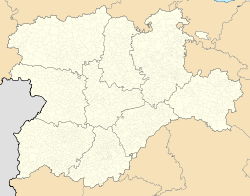
Back Tordesillas AN توردسيلاس Arabic توردسيلاس ARZ تردسییاس AZB Tordesillas Catalan Тордесильяс CE Tordesillas (munisipyo) CEB Tordesillas Czech Tordesillas German Tordesillas Esperanto
Tordesillas | |
|---|---|
 Southern Tordesillas in September 2012. | |
| Coordinates: 41°30′N 5°00′W / 41.500°N 5.000°W | |
| Country | |
| Autonomous community | |
| Province | Valladolid |
| Comarca | Tierra del Vino |
| Government | |
| • Mayor | María del Milagro Zarzuelo Capellán (PP) |
| Area | |
• Total | 141.95 km2 (54.81 sq mi) |
| Elevation | 704 m (2,310 ft) |
| Population (2018)[1] | |
• Total | 8,825 |
| • Density | 62/km2 (160/sq mi) |
| Demonym | Tordesillanos |
| Time zone | UTC+1 (CET) |
| • Summer (DST) | UTC+2 (CEST) |
| Postal code | 47100 |
| Website | Official website |
Tordesillas (Spanish pronunciation: [toɾðeˈsiʎas]) is a town and municipality in the province of Valladolid, Castile and León, central Spain. It is located 25 kilometres (16 mi) southwest of the provincial capital, Valladolid at an elevation of 704 metres (2,310 ft). The population was c. 8,760 as of 2021[update].[2]
The town is located on the Douro River although the river is not navigable up to Tordesillas. There are highway connections to Madrid, 182 kilometres (113 mi) to the southeast, and with Salamanca, 96 kilometres (60 mi) to the southwest. The provincial capital of Valladolid is also linked by four-lane highway.
Because of its important highway connections Tordesillas has become a major transit hub. The economy is based on services—especially connected to tourism—and the agricultural production of the surrounding area. Wheat has long been the traditional agricultural product (see Cuisine of the province of Valladolid).
The town is well served by hotels with a Parador, four three-star hotels, one two-star hotel, and ten hostels and pensions. There is also a camping site. There is also an abundance of restaurants—27 in total—with the Parador restaurant having a three star classification. North of the town there is a fertile valley formed by the Douro, with extensive use of irrigation by central pivots.
The town is known for its Toro de la Vega festival during which a bull was slaughtered by people on horseback and on foot. Animal rights groups repeatedly tried to stop this from taking place.
- ^ Municipal Register of Spain 2018. National Statistics Institute.
- ^ "Instituto Nacional de Estadística. (Spanish Statistical Institute)". www.ine.es. Retrieved 9 March 2024.



